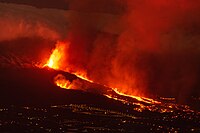
Photo from wikipedia
Abstract This study presents a photogrammetric method for 3D reconstruction of a volcanic plume outline to retrieve its spatial properties. A dataset of sequential multi-view images was collected, using a… Click to show full abstract
Abstract This study presents a photogrammetric method for 3D reconstruction of a volcanic plume outline to retrieve its spatial properties. A dataset of sequential multi-view images was collected, using a drone-mounted camera, for a small-scale volcanic plume emitted from Volcan Pacaya, Guatemala. A ‘Space Carving’ algorithm has been applied to estimate the plume shape, top height, volume and drift direction. The complete method workflow is presented herein, including data capture, camera projection, image segmentation, and model reconstruction. The process applied is considered the simplest approach to reconstruct a 3D plume model from sequential imagery, whilst accounting for scene evolution within a probabilistic framework. The algorithm is sensitive to the method of image segmentation, scene resolution and number of images used, with unquantifiable uncertainty in the estimated plume volume due to the lack of ground-truth data. This proof-of-concept investigation confirms that 3D quantification of volcanic plume geometry can be achieved using UAS-based photogrammetry and shows promising results for a new method of measuring volcanic source parameters to validate and adjust dispersion models of volcanic plumes.
Journal Title: Journal of Volcanology and Geothermal Research
Year Published: 2020
Link to full text (if available)
Share on Social Media: Sign Up to like & get
recommendations!